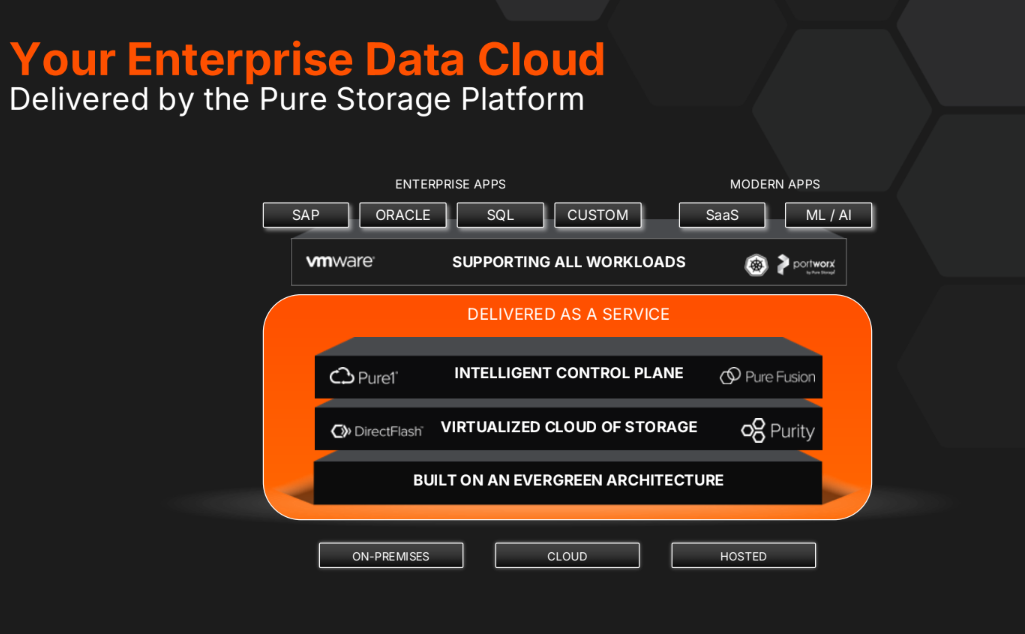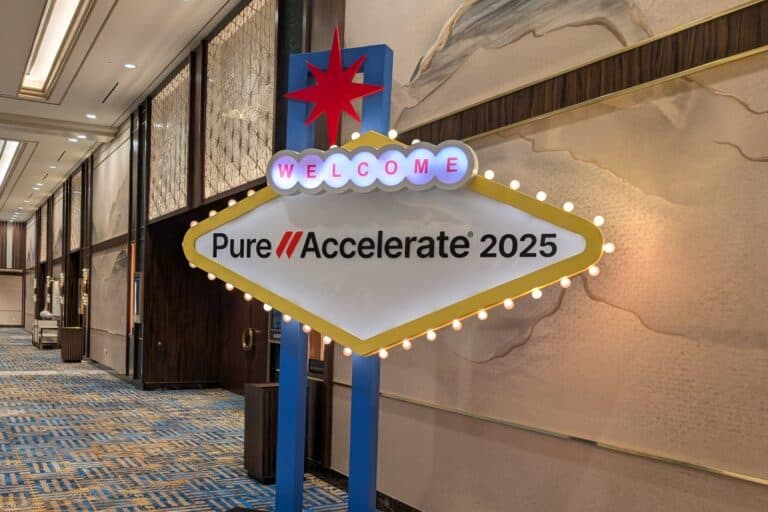Pure announced the Enterprise Data Cloud today at Pure Accelerate. With this architecture, it aims to enable organizations to manage data rather than storage. We explain what Pure means by this below.
Enterprise Data Cloud (EDC) is not particularly special in itself. In other words, it is not a new product, new service, or other type of offering from Pure. It is an architecture that follows more or less logically from everything Pure has built up over the 15 years of its existence. The company has been working toward a comprehensive storage platform for many years. This has now been given a “formal” architecture.
The basis for the Enterprise Data Cloud consists of three parts. First, everything Pure does must meet its Evergreen architecture requirements. Customers must always be able to migrate to the latest hardware and software without any problems. On top of that, there is a very extensive portfolio of products, all of which use DirectFlash Modules (DFMs), have the same code base, and run on the Purity OS. Finally, there is the data management layer, with Pure1 and Pure Fusion. This ensures that it is actually possible to centrally manage all storage within an organization.
Pure Fusion is the engine of the Enterprise Data Cloud
We mentioned Pure Fusion above. It is no exaggeration to say that this forms the core of what Pure now calls the Enterprise Data Cloud. The company has been working on this component since 2021, and we have previously described it as storage-as-code. Pure Fusion makes it possible to view all storage as a single storage pool. It is an extra layer of abstraction that allows you to manage an entire fleet of arrays at once without having to know what they all are and where they are located. It integrates with Pure1 and the insights that component provides and should enable workflows to be orchestrated and automated.
The introduction of Pure Fusion was and is very important for Pure. It was also quite a task to make the first version from 2021, which only worked in greenfield environments, suitable for all environments. Pure worked on it for three years before releasing an improved version last year. Since then, Pure Fusion has been embedded in all of the company’s arrays, whereas it was offered from the cloud before that time. In the words of Rob Lee, Pure Storage’s CTO: “Fusion is an intelligent control plane in the bowels of Purity.”

Optimizing and automating workflows
Without Pure Fusion, Pure would not have been able to further develop its Enterprise Data Cloud architecture. With Fusion, all arrays are linked together and there is also a reinforcing effect, Lee explains. In other words, the more arrays you connect to each other via Pure Fusion, the more they cooperate and interact. This enables new possibilities, such as federated management of the fleet of arrays within an organization.
Ultimately, Pure Fusion is not just about automatically detecting and adding storage in an environment, regardless of the protocol (file, block, object). Management concepts at a higher level also come into play. Think of presets and specific workloads that must follow a certain policy. An example of this would be an Oracle database rollout with a specific RTO/RPO (Recovery Time Objective and Recovery Point Objective, respectively).
Pure Fusion also makes it possible to orchestrate workflows and automate them to a considerable extent. To this end, Pure has added thousands of application connectors and ‘recipes’. Again, with a specific policy as the starting point, Fusion ensures that the deployment and management of databases, compute, network, and links to other components can be automated. Crucial here is that it is a declarative process. By choosing a specific ‘recipe’, you indicate the end goal of what you have in mind. Pure Fusion then takes it from there. You don’t have to manage and configure the arrays yourself.
Enterprise Data Cloud is a sign of the times
With the announcement of the Enterprise Data Cloud architecture, Pure has put the finishing touches on the work it has done over the past 15 years (even though it is not done yet, of course). It is also a development that we are seeing quite widely in the market. Cisco came out with the Networking Cloud a few years ago, and closer to home for Pure, NetApp launched the Intelligent Data Infrastructure last year, which is similar (although both camps will of course claim that it is much more nuanced). There is apparently a need in the market for these kinds of terms to be able to tell a broader story.
To a certain extent, the Enterprise Data Cloud architecture is therefore old wine in new bottles. No one denies this, not even Pure. But simply dismissing it as a nice layer of makeup on a vision is also somewhat reductive. It does represent a different way of looking at storage. Not as a collection of arrays with a lot of petabytes of capacity, but much more as a collection of data that you, as a company, can and must do all kinds of interesting and necessary things with. By abstracting this further, organizations can focus on what they want to do with that data instead of how they need to set things up and configure them.
We are now waiting for more agentic AI capabilities within this architecture (i.e., within Pure Fusion). When we hear and read about automating and optimizing workflows, that’s always the first thing that comes to mind. At its core, agentic AI is nothing more than optimizing workflows with the help of some extra (autonomous) intelligence. This presents additional opportunities for Pure to further reduce the burden on organizations. In any case, there is still plenty of room for expansion in the new architecture.
Are organizations ready for it?
In theory, the Enterprise Data Cloud architecture sounds good, in our opinion. However, the big question for us is how many organizations are ready to embark on an Enterprise Data Cloud journey. Many organizations will not only have storage from Pure, but also from other vendors. There will also undoubtedly be all sorts of questions raised about how laws and regulations can be incorporated into this architecture. And what about requirements around airgapped environments? Finally, if we look at AI projects, these are often started up in silos and should not be part of a global storage pool.
In principle, Pure can probably solve these issues in Pure Fusion, and may have already solved some of them. The more fundamental question might be how questions, wishes and exceptions like the ones above impact the desired simplicity of the new architecture. Surely, having customers do their own customizations is not the solutions. That goes against one of the key points of the architecture, which is to cut out manual tasks. In any case, we are curious to see how this is going to develop in the next year.
